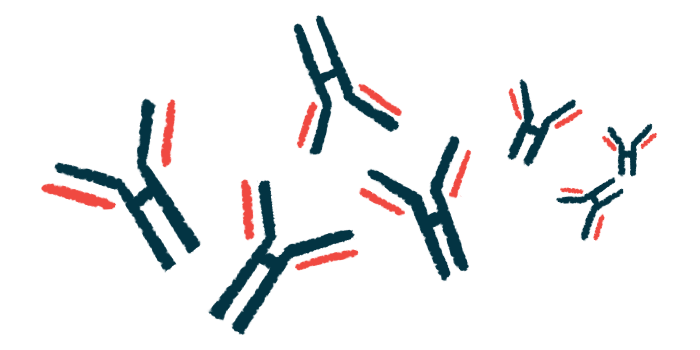Antibody levels affecting Zolgensma transient in SMA children
High titers also not common, found in 13% of 882 young patients in US study
Written by |

Elevated levels of neutralizing antibodies against AAV9, which can reduce the efficacy of the gene therapy Zolgensma (onasemnogene abeparvovec), were uncommon in infants and young children with spinal muscular atrophy (SMA), a study found.
It also showed that anti-AAV9 antibody levels, highest in early infancy, declined over time, and most patients with elevated levels at a first test eventually were able to receive Zolgensma.
“Understanding the prevalence of preexisting [anti-AAV9 antibodies] is essential for evaluating the possibility of gene therapy for SMA,” the researchers wrote.
Scientists also stressed the importance of treating SMA as early as possible, and suggested that patients with elevated antibodies be given disease-modifying therapies that work through different mechanisms — Spinraza (nusinersen) or Evrysdi (risdiplam) — as “bridge treatments” until able to receive Zolgensma.
Zolgensma is the only approved SMA gene therapy
The study, “Adeno-Associated Virus Serotype 9 Antibody Seroprevalence for Patients in the United States with Spinal Muscular Atrophy,” was published in the journal Molecular Therapy – Methods & Clinical Development. Novartis, which markets Zolgensma, sponsored the study and three company scientists took part in it.
SMA is caused by mutations in the SMN1 gene, leading to a deficiency in the SMN protein, which is essential for the proper functioning of nerve cells that control voluntary movement. As a result, communication between nerves and muscles is impaired, giving rise to muscle weakness and muscle wasting.
Zolgensma is designed to provide patients with a working copy of the SMN1 gene, with the goal of increasing SMN production. Real-world studies of Zolgensma, and the treatment’s clinical trials, suggest that it is safe and effective, especially when administered within the first months of life.
The gene therapy is delivered to cells in the body by a harmless, modified virus called adeno-associated virus serotype 9 (AAV9). While naturally occurring AAVs are not known to cause disease, exposure can prompt an immune response and the generation of antibodies that neutralize the virus.
In young SMA patients with elevated levels of anti-AAV9 antibodies (AAV9-Ab), the efficacy and safety of Zolgensma may be compromised.
“When [Zolgensma] treatment for SMA is a goal for health care providers and families, determining treatment appropriateness by testing and retesting AAV9-Ab concentrations as soon as possible is preferred,” the researchers wrote.
Newborns can acquire anti-AAV9 antibodies before birth, via the placenta
Anti-AAV immunity in newborns is derived from the transfer of these antibodies, mainly via the placenta, from mothers that acquired them through exposure, often environmental. Maternal antibodies provide immunity during the first few months of life, but their levels, or titers, decrease over time.
A team led by researchers at Stanford University Medical Center in California and Ohio State University measured levels of maternally transferred antibodies in babies and young children with SMA living in the U.S.
Their goal was to provide a better understanding of the prevalence and clearance of these antibodies in this patient population.
The 882 patients in the study were almost evenly split between boys (51.8%) and girls (48.2%), with a mean age of around 6 months (range 1 day to about 3 years old) at the first test for AAV9 antibodies. A total of 141 patients (16.0%) underwent retesting at a later date, 83 (58.9%) with elevated antibody titers at the first test and 58 (41.1%) with non-elevated titers.
Among all 882 patients, blood tests revealed 115 (13.0%) had elevated titers of antibodies that bind AAV9. Those with elevated titers were younger than patients with non-elevated titers, and the percentage with high titers decreased with age.
Anti-AAV9 antibody prevalence was highest in infants age 3 months and younger, and they dropped markedly after age 9 months, “consistent with a decline of passively transferred antibodies over time,” the researchers wrote.
In the youngest age groups, elevated titers were seen in 74 of 414 (17.9%) infants less than 4 weeks old, 12 of 59 infants (20.3%) 1 to 2 months old, and six of 34 babies (17.6%) 2 to 3 months old.
Although the greatest percentage of SMA children with elevated anti-AAV9 titers were found in Wyoming, Kentucky, Missouri, and North Carolina, there were no clear geographical patterns across the U.S.
Lower antibody levels generally reached safe levels within 6 weeks
When patients underwent repeat testing, non-elevated antibody titers often were found. Overall, 65 infants age 6 weeks or younger had an elevated first test result and underwent repeat testing, with only one child showing elevated titers across repeat testing given until age 14 months.
Antibody levels decreased from elevated to non-elevated for most patients, and they were able to be treated with Zolgensma. Lower titers dropped to non-elevated levels more rapidly, generally within six weeks, than did higher titers, which took several months to decline.
“For pediatric patients with SMA, elevated titers of AAV9-Ab at initial testing do not preclude treatment with [Zolgensma] gene therapy once titers decrease to normal levels,” the researchers concluded. “Overall, elevated AAV9-Ab titers are uncommon among infants and young children with SMA and almost all patients are eventually able to receive [Zolgensma].”







